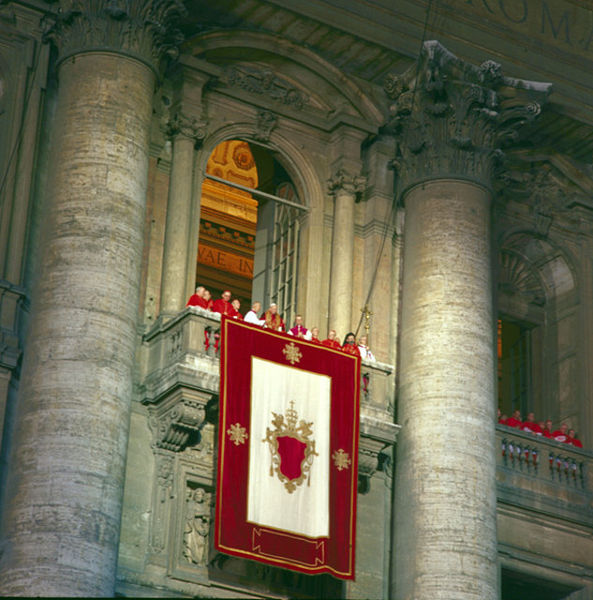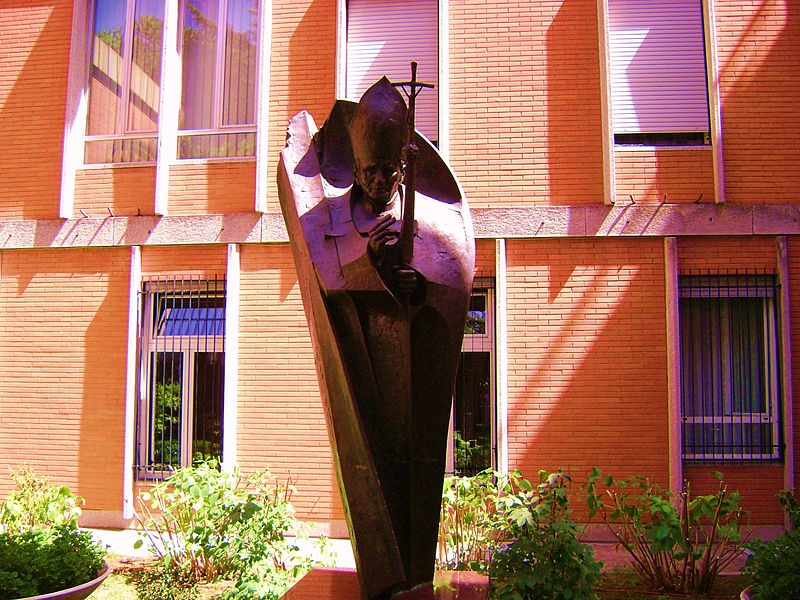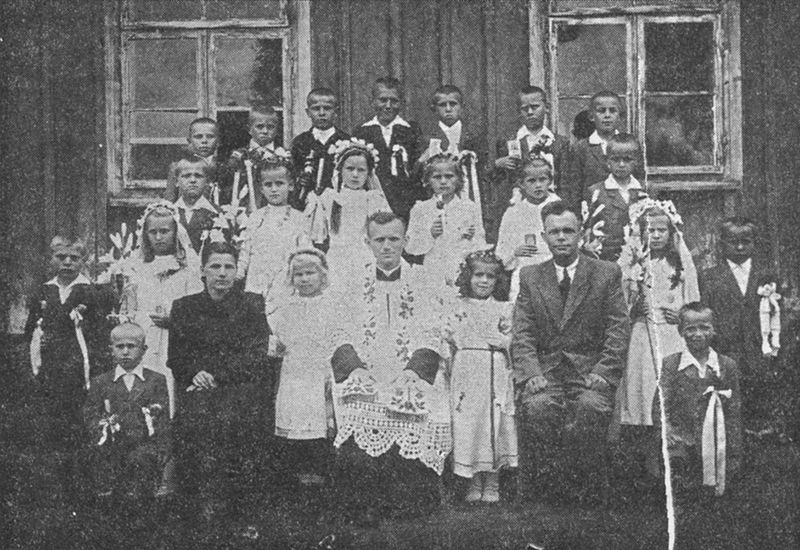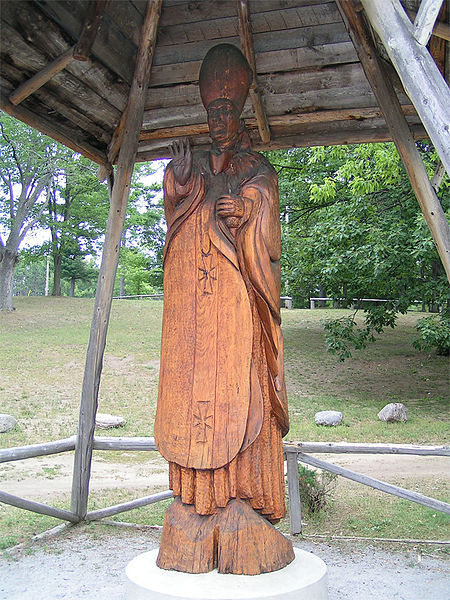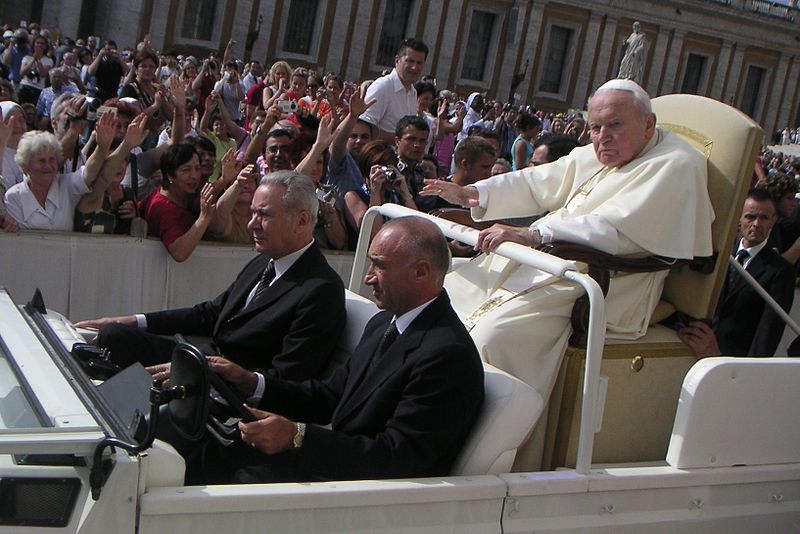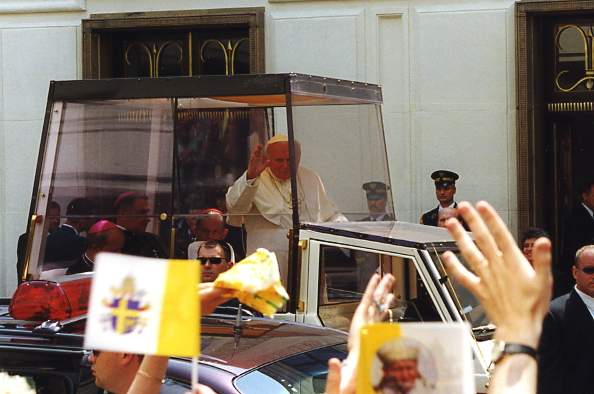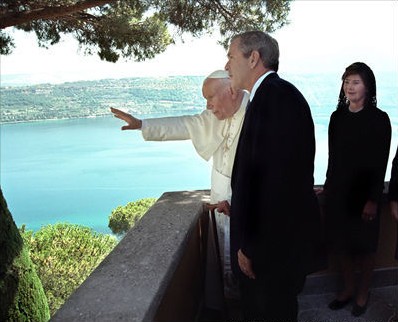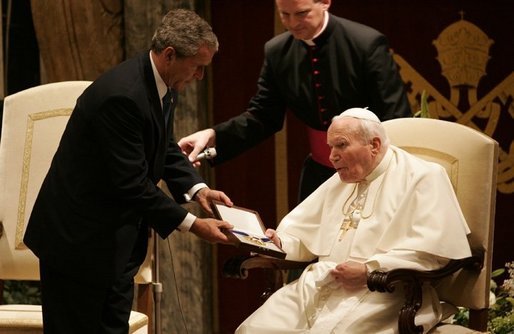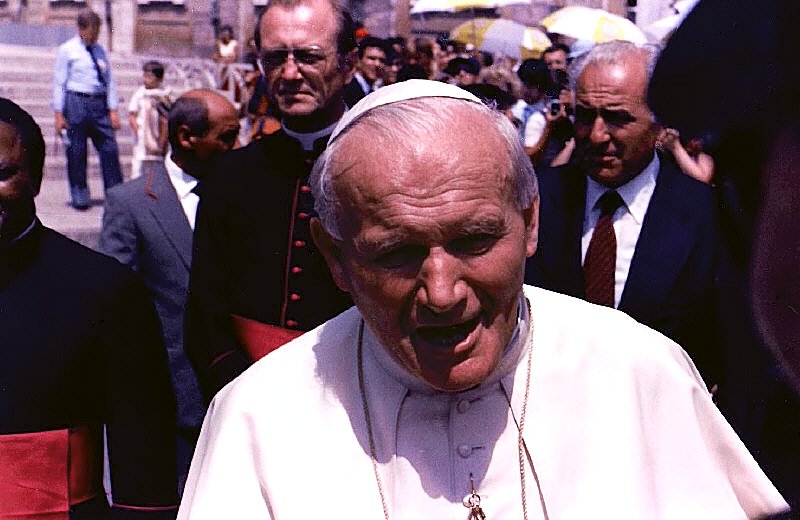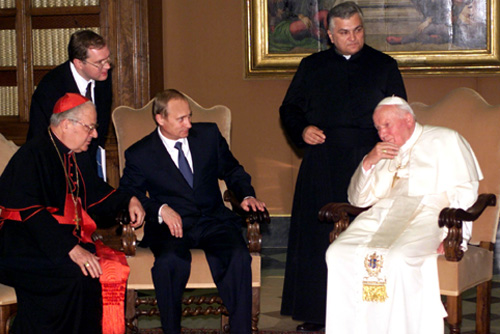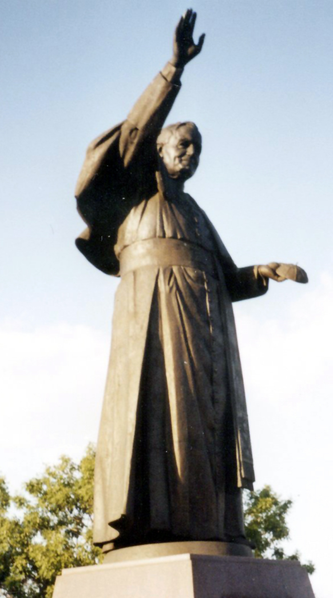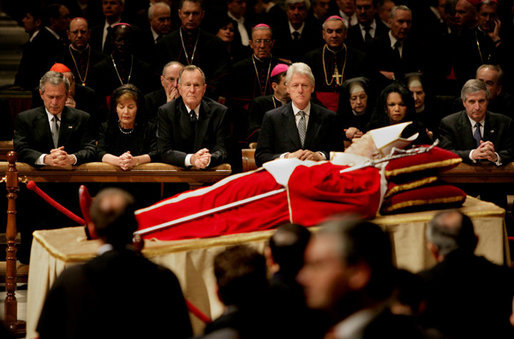<Back to Index>
- Pope John Paul II, 1920
PAGE SPONSOR
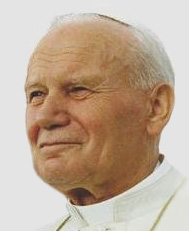
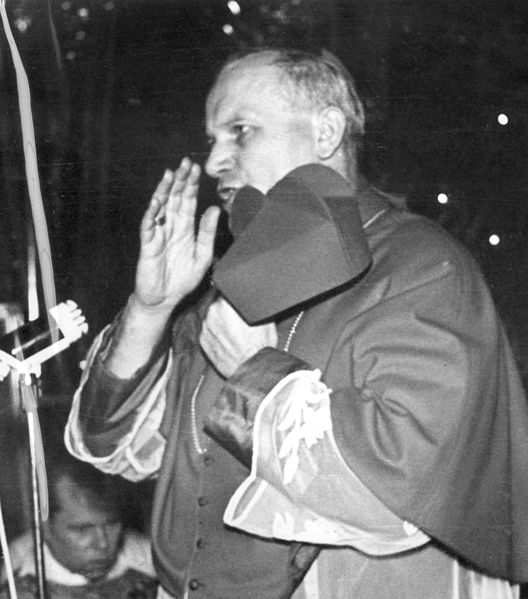
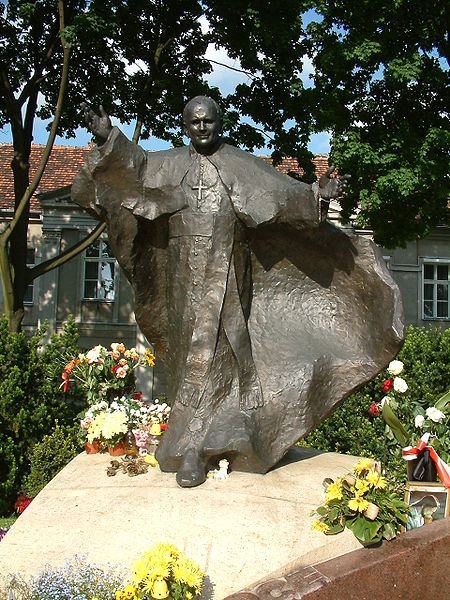
Blessed Pope John Paul II (Latin: Ioannes Paulus PP. II, Italian: Giovanni Paolo II, Polish:Jan Paweł II), born Karol Józef Wojtyła (18 May 1920 – 2 April 2005), reigned as Pope of the Catholic Church and Sovereign of Vatican City from 16 October 1978 until his death on 2 April 2005, at 84 years and 319 days of age. His was the second longest documented pontificate, which lasted 26 years and 168 days; only Pope Pius IX (1846 – 1878) who served 31 years, has reigned longer. Pope John Paul II is the only Slavic or Polish pope to date and was the first non - Italian Pope since Dutch Pope Adrian VI (1522 – 1523).
John Paul II has been acclaimed as one of the most influential leaders of the 20th century. It is widely held that he was instrumental in ending communism in his native Poland and eventually all of Europe. Conversely, he denounced the excesses of capitalism. John Paul II is widely said to have significantly improved the Catholic Church's relations with Judaism, Islam, the Eastern Orthodox Church, and the Anglican Communion. Though criticised by progressives for upholding the Church's teachings against artificial contraception and the ordination of women, he was also criticised by traditionalists for his support of the Church's Second Vatican Council and its reform of the Liturgy as well as his ecumenical efforts.
He
was one of the most travelled world leaders in history, visiting
129 countries during his pontificate. He spoke Italian, French,
German, English, Spanish, Portuguese, Russian, Croatian, and Latin as well as his native Polish. As part of his special emphasis on the universal call to holiness, he beatified 1,340 people and canonised 483 saints,
more than the combined tally of his predecessors during the last five
centuries. On 19 December 2009, John Paul II was
proclaimed venerable by his successor Pope Benedict XVI and was beatified on 1 May 2011.
Karol Józef Wojtyła (Anglicised: Charles Joseph Wojtyla) was born in the Polish town of Wadowice and was the youngest of three children of Karol Wojtyła, an ethnic Pole, and Emilia Kaczorowska, who is described as being of Lithuanian or Ukrainian ancestry. His mother died on 13 April 1929, when he was eight years old. Karol's elder sister, Olga, had died in infancy before his birth; thus, he grew close to his brother Edmund, who was 14 years his senior, and whom he nicknamed Mundek. However, Edmund's work as a physician led to his death from scarlet fever, profoundly affecting Karol.
As a youth, Wojtyła was an athlete and often played football as a goalkeeper. His formative years were influenced by numerous contacts with the vibrant and prospering Jewish community of Wadowice. School football games were often organised between teams of Jews and Catholics, and Wojtyła would voluntarily offer himself as a substitute goalkeeper on the Jewish side if they were short of players.
In mid 1938, Karol Wojtyła and his father left Wadowice and moved to Kraków, where he enrolled at the Jagiellonian University. While studying such topics as philology and various languages at the University, he worked as a volunteer librarian and was required to participate in compulsory military training in the Academic Legion, but he refused to fire a weapon. He performed with various theatrical groups and worked as a playwright. During this time, his talent for language blossomed and he learned as many as 12 foreign languages, nine of which he later used extensively as Pope.
In 1939, Nazi German occupation forces closed the Jagiellonian University after the invasion of Poland. All able - bodied males were required to work, and, from 1940 to 1944, Wojtyła variously worked as a messenger for a restaurant, a manual labourer in a limestone quarry and for the Solvay chemical factory to avoid being deported to Germany. His father, a non - commissioned officer in the Polish Army, died of a heart attack in 1941, leaving Karol the sole surviving member of his immediate family. "I was not at my mother's death, I was not at my brother's death, I was not at my father's death," he said, reflecting on these times of his life, nearly forty years later, "At twenty, I had already lost all the people I loved."
He later stated that he began thinking seriously about the priesthood after his father's death, and that his vocation gradually became ‘an inner fact of unquestionable and absolute clarity.’ In October 1942, increasingly aware of his calling to the priesthood, he knocked on the door of the Archbishop's Palace in Kraków, and declared that he wanted to study for the priesthood. Soon after, he began courses in the clandestine underground seminary run by the Archbishop of Kraków, Adam Stefan Cardinal Sapieha.
On 29 February 1944, Wojtyła was knocked down by a German truck. German Wehrmacht officers then tended to him and sent him to a hospital. He spent two weeks there recovering from a severe concussion and a shoulder injury. This accident and his survival seemed to Wojtyła a confirmation of his priestly vocation. On 6 August 1944, ‘Black Sunday’, the Gestapo rounded up young men in Kraków to avoid an uprising similar to the previous uprising in Warsaw. Wojtyła escaped by hiding in the basement of his uncle's home at 10 Tyniecka Street, while German troops searched upstairs. More than eight thousand men and boys were taken into custody that day, but he escaped to the Archbishop's Palace, where he remained in hiding until after the Germans left.
On the night of 17 January 1945, the Germans fled the city, and the students reclaimed the ruined seminary.
Wojtyła and another seminarian volunteered for the unenviable task of
clearing away piles of frozen excrement from the lavatories. That month, Wojtyła personally aided a 14 year old Jewish refugee girl named Edith Zierer who had run away from a Nazi labour camp in Częstochowa. After her collapse on a railway platform,
Wojtyła carried her to a train and accompanied her safely to
Kraków. Zierer credits Wojtyła with saving her life that day. B'nai B'rith and other authorities have said that Wojtyla helped protect many other Polish Jews from the Nazis.
On completion of his studies at the seminary in Kraków, Karol Wojtyła was ordained as a priest on All Saints' Day, 1 November 1946, by the Archbishop of Kraków, Cardinal Sapieha. He was then sent to study theology in Rome, at the Pontifical International Athenaeum Angelicum, where he earned a licentiate and later a doctorate in sacred theology. This doctorate, the first of two, was based on the Latin dissertation The Doctrine of Faith According to Saint John of the Cross.
He returned to Poland in the summer of 1948 with his first pastoral assignment in the village of Niegowić,
fifteen miles from Kraków. Arriving at Niegowić during harvest
time, his first action was to kneel down and kiss the ground. This gesture, adapted from French saint Jean Marie Baptiste Vianney, would become one of his ‘trademarks’ during his Papacy.
In March 1949, Wojtyła was transferred to the parish of Saint Florian in Kraków. He taught ethics at the Jagiellonian University and subsequently at the Catholic University of Lublin. While teaching, he gathered a group of about 20 young people, who began to call themselves Rodzinka, the "little family". They met for prayer, philosophical discussion, and helping the blind and sick. The group eventually grew to approximately 200 participants, and their activities expanded to include annual skiing and kayaking trips.
In 1954, he earned a second doctorate, in philosophy, evaluating the feasibility of a Catholic ethic based on the ethical system of phenomenologist Max Scheler. However, the Communist authorities' intervention prevented his receiving the degree until 1957.
During this period, Wojtyła wrote a series of articles in Kraków's Catholic newspaper Tygodnik Powszechny ("Universal Weekly") dealing with contemporary church issues. He focused on creating original literary work during
his first dozen years as a priest. War, life under Communism, and his
pastoral responsibilities all fed his poetry and plays. However, he
published his work under two pseudonyms – Andrzej Jawień and Stanisław
Andrzej Gruda –
to distinguish his literary from his religious writings (which were
published under his own name) and also so that his literary works would
be considered on their own merits. In 1960, Wojtyła published the influential theological book Love and Responsibility, a defence of the traditional Church teachings on marriage from a new philosophical standpoint.
On 4 July 1958, while Wojtyła was on a kayaking vacation in the lakes region of northern Poland, Pope Pius XII appointed him to the position of auxiliary bishop of Kraków. He was then summoned to Warsaw to meet the Primate of Poland, Stefan Cardinal Wyszyński, who informed him of the appointment. He agreed to serve as auxiliary to Archbishop Eugeniusz Baziak, and he was ordained to the Episcopate (using the title Bishop of Ombi) on 28 September 1958. At the age of 38, he became the youngest bishop in Poland. Baziak died in June 1962 and on 16 July, Karol Wojtyła was selected as Vicar Capitular, or temporary administrator, of the Archdiocese until an Archbishop could be appointed.
Beginning in October 1962, Bishop Wojtyła took part in the Second Vatican Council (1962 – 1965), where he made contributions to two of the most historic and influential products of the council, the Decree on Religious Freedom (in Latin, Dignitatis Humanae) and the Pastoral Constitution on the Church in the Modern World (Gaudium et Spes).
Bishop Wojtyła participated in all the assemblies of the Synod of Bishops. On 13 January 1964, Pope Paul VI appointed him Archbishop of Kraków. On 26 June 1967, Paul VI announced Archbishop Wojtyła's promotion to the Sacred College of Cardinals. He was named Cardinal - Priest of the titulus of San Cesareo in Palatio.
In 1967, he was instrumental in formulating the encyclical Humanae Vitae, which deals with the same issues that forbid abortion and artificial birth control. According to a contemporary witness, Cardinal Wojtyla in 1970 was against the
distribution and reading in the Kraków diocese a pastoral letter
that the Polish Episcopate was preparing for the 50th anniversary of the Polish - Soviet War.
In August 1978, following the death of Pope Paul VI, Cardinal Wojtyła voted in the Papal conclave that elected Pope John Paul I, who at 65 was considered young by papal standards. John Paul I died after only 33 days as Pope, thereby precipitating another conclave.
The second conclave of 1978 commenced on 14 October, ten days after the funeral of Pope John Paul I. It was divided between two strong candidates for the papacy: Giuseppe Cardinal Siri, the conservative Archbishop of Genoa, and the liberal Archbishop of Florence, Giovanni Cardinal Benelli, a close associate of John Paul I.
Supporters of Benelli were confident that he would be elected, and in early ballots, Benelli came within nine votes of election. However, the scale of opposition to both men meant that neither was likely to receive the votes needed for election, and Franz Cardinal König, Archbishop of Vienna, individually suggested to his fellow electors a compromise candidate: the Polish Cardinal, Karol Józef Wojtyła. Wojtyła ultimately won the election on the eighth ballot on the second day with, according to the Italian press, 99 votes from the 111 participating electors. He subsequently chose the name John Paul II in honour of his immediate predecessor, and the traditional white smoke informed the crowd gathered in St. Peter's Square that a pope had been chosen. He accepted his election with these words: ‘With obedience in faith to Christ, my Lord, and with trust in the Mother of Christ and the Church, in spite of great difficulties, I accept.’ When the new pontiff appeared on the balcony, he broke tradition by addressing the gathered crowd:
| “ | Dear brothers and sisters, we are saddened at the death of our beloved Pope John Paul I, and so the cardinals have called for a new bishop of Rome. They called him from a faraway land – far and yet always close because of our communion in faith and Christian traditions. I was afraid to accept that responsibility, yet I do so in a spirit of obedience to the Lord and total faithfulness to Mary, our most Holy Mother. I am speaking to you in your – no, our Italian language. If I make a mistake, please ‘kirrect’ [sic] me... | ” |
Wojtyła became the 264th Pope according to the chronological list of popes and the first non - Italian Pope in 455 years. At only 58 years of age, he was the youngest pope elected since Pope Pius IX in 1846, who was 54. Like his immediate predecessor, Pope John Paul II dispensed with the traditional Papal coronation and instead received ecclesiastical investiture with the simplified Papal inauguration on 22 October 1978. During his inauguration, when the cardinals were to kneel before him to take their vows and kiss his ring, he stood up as the Polish prelate Stefan Cardinal Wyszyński knelt down, stopped him from kissing the ring, and hugged him.
“The future starts today, not tomorrow.”
—Pope John Paul II
As pope, one of John Paul II's most important roles was to teach people about Christianity. He wrote 14 papal encyclicals and taught about "The Theology of the Body".
In his At the beginning of the third millennium (Novo Millennio Ineunte), he emphasised the importance of "starting afresh from Christ": "No, we shall not be saved by a formula but by a Person."
In The Splendour of the Truth (Veritatis Splendor), he emphasised the dependence of man on God and His Law ("Without the Creator, the creature disappears") and the "dependence of freedom on the truth". He warned that man "giving himself over to relativism and skepticism, goes off in search of an illusory freedom apart from truth itself".
In Fides et Ratio (On the Relationship between Faith and Reason) John Paul promoted a renewed interest in philosophy and an autonomous pursuit for truth in theological matters. Drawing on many different sources (such as Thomism), he described the mutually supporting relationship between faith and reason, and emphasised that theologians should focus on that relationship.
John Paul II wrote extensively about workers and the social doctrine of the Church, which he discussed in three encyclicals. Through his encyclicals and many Apostolic Letters and Exhortations, John Paul talked about the dignity of women and the importance of the family for the future of humanity.
Other encyclicals include The Gospel of Life (Evangelium Vitae) and Ut Unum Sint (That They May Be One). Despite critics who accused him of inflexibility, he explicitly re-asserted Catholic moral teachings against murder, euthanasia and abortion that have been in place for well over a thousand years.
| “ | As the family goes, so goes the nation and so goes the whole world in which we live. | ” |
—Pope John Paul II | ||
During his pontificate, Pope John Paul II made trips to 129 countries, and logged more than 1.1 million km (725,000 miles). He consistently attracted large crowds on his travels, some amongst the largest ever assembled in human history like the Manila World Youth Day, which gathered around 5 million people. Some have suggested that it may have been the largest Christian gathering ever, although this is not certain.
John Paul II's earliest official visits were to the Dominican Republic and Mexico in January 1979 and to Poland in June 1979, where ecstatic crowds constantly surrounded him. This first trip to Poland uplifted the whole nation's spirit and sparked the formation of the Solidarity movement in 1980, which brought freedom and human rights to his troubled country. On later trips to Poland, he gave tacit support to the organization. Successive trips reinforced this message and Poland began the process that would finally defeat the domination of communist regimes under the lead of the Soviet Union in Central Europe between 1989 (reintroduction of democracy in Poland) and 1990, Eastern Europe (1990 – 1991) and South - Eastern Europe (1990–1992).
While some of his trips (such as to the United States and the Holy Land) were to places previously visited by Pope Paul VI, John Paul II became the first pope to visit the White House during his October 1979 U.S. trip, where he was greeted warmly by then President Jimmy Carter. He travelled to countries that no pope had ever visited before. He was the first pope to visit Mexico in January 1979, before his initial trip to Poland as Pope, as well as to Ireland later that year. He was the first reigning pope to travel to the United Kingdom, in 1982, where he met Queen Elizabeth II, the Supreme Governor of the Church of England. He travelled to Haiti in 1983, where he spoke in Creole to thousands of impoverished Catholics gathered to greet him at the airport. His message, "things must change in Haiti", referring to the disparity between the wealthy and the poor, was met with thunderous applause. In 2000, he was the first modern pope to visit Egypt, where he met with the Coptic pope, Pope Shenouda III and the Greek Orthodox Patriarch of Alexandria. He was the first Catholic pope to visit and pray in an Islamic mosque, in Damascus, Syria, in 2001. He visited the Umayyad Mosque, a former Christian church where John the Baptist is believed to be interred, where he made a speech calling for Muslims, Christians and Jews to work together.
On 15 January 1995, during the X World Youth Day, he offered Mass to an estimated crowd of between five and seven million in Luneta Park, Manila, Philippines, which was considered to be the largest single gathering in Christian history. In March 2000, while visiting Jerusalem, John Paul became the first pope in history to visit and pray at the Western Wall. In September 2001, amidst post 11 September concerns, he travelled to Kazakhstan, with an audience largely consisting of Muslims, and to Armenia, to participate in the celebration of the 1,700 years of Christianity in that nation.
| “ | Today, for the first time in history, a Bishop of Rome sets foot on English soil. This fair land, once a distant outpost of the pagan world, has become, through the preaching of the Gospel, a beloved and gifted portion of Christ's vineyard. | ” |
—Pope John Paul II (1982) | ||
John Paul II had a special relationship with Catholic youth and is known by some as The Pope for Youth. Before he was pontiff, he used to camp and mountain hike with the youth. He still went mountain hiking when he was pope. He was concerned with the education of future priests and made many early visits to Roman seminaries, including to the Venerable English College in 1979. He established World Youth Day in 1984 with the intention of bringing young Catholics from all parts of the world together to celebrate the faith. These week long meetings of youth occur every two or three years, attracting hundreds of thousands of young people, who go there to sing, party, have a good time and deepen their faith. The 19 World Youth Days celebrated during his pontificate brought together millions of young people from all over the world. During this time, his care for the family was expressed in the World Meetings of Families, which he initiated in 1994.
| “ | Young people are threatened... by the evil use of advertising techniques that stimulate the natural inclination to avoid hard work by promising the immediate satisfaction of every desire. | ” |
—Pope John Paul II | ||
Pope John Paul II had good relations with the Church of England, referred to by his predecessor Pope Paul VI, as "our beloved Sister Church". He preached in Canterbury Cathedral during his visit to Great Britain, and received the Archbishop of Canterbury with friendship and courtesy. However, John Paul II was disappointed by the Church of England's decision to offer the Sacrament of Holy Orders to women and saw it as a step in the opposite direction from unity between the Anglican Communion and the Catholic Church.
In 1980 John Paul II issued a Pastoral Provision allowing married former Episcopal priests to become Catholic priests, and for the acceptance of former Episcopal Church parishes into the Catholic Church. He allowed the creation of the Anglican Use form of the Latin Rite, which incorporates the Anglican Book of Common Prayer.
John Paul II's historic ecumenical effort with the Anglican Communion
was realised with the establishment of Our Lady of the Atonement Catholic Church (Anglican Use), in cooperation with Archbishop Patrick Flores of San Antonio, TX, in the United States.
On 15 – 19 November 1980 John Paul II visited the Federal Republic of Germany on his first trip to a country with a large Lutheran population. In Mainz he met with leaders of the Lutheran and other Protestant Churches, and with representatives of other Christian denominations.
On 11 December 1983 John Paul II participated in an ecumenical service in the Evangelical Lutheran Church in Rome, the first papal visit ever to a Lutheran church. The visit took place 550 years after the birth of Martin Luther, the German Augustinian monk who initiated the Lutheran reformation.
In his apostolic pilgrimage to Norway, Iceland, Finland, Denmark and Sweden 1 – 10 June 1989, John Paul II became the first pope to visit countries with Lutheran majorities. In addition to celebrating Mass with Catholic believers, he participated in ecumenical services at places that had been Catholic shrines before the Lutheran reformation in the 16th century: Nidaros Cathedral in Norway; near St. Olav's Church at Thingvellir in Iceland; Turku Cathedral in Finland; Roskilde Cathedral in Denmark; and Uppsala Cathedral in Sweden.
On 31 October 1999 (the 482nd anniversary of Reformation Day, Martin Luther's posting of the 95 Theses), representatives of the Vatican and the Lutheran World Federation (LWF) signed a Joint Declaration on the Doctrine of Justification,
as a gesture of unity. The signing was a fruit of the theological
dialogue that has been going on between the LWF and the Vatican since 1965.
Relations between Catholicism and Judaism improved during the pontificate of John Paul II. He spoke frequently about the Church's relationship with Jews.
As a child, Karol Wojtyła had played sports with his many Jewish neighbours. In 1979, he became the first Pope to visit the German Auschwitz concentration camp in Poland, where many of his compatriots (mostly Polish Jews) had perished during the Nazi occupation in World War II. In 1998 he issued "We Remember: A Reflection on the Shoah" which outlined his thinking on the Holocaust. He became the first pope known to have made an official papal visit to a synagogue, when he visited the Great Synagogue of Rome on 13 April 1986.
In 1994, John Paul II established formal diplomatic relations between the Holy See and the State of Israel, acknowledging its centrality in Jewish life and faith. In honour of this event, Pope John Paul II hosted ‘The Papal Concert to Commemorate the Holocaust’. This concert, which was conceived and conducted by American Maestro Gilbert Levine, was attended by the Chief Rabbi of Rome, the President of Italy, and survivors of the Holocaust from around the world.
In March 2000, John Paul II visited Yad Vashem, the national Holocaust memorial in Israel, and later made history by touching one of the holiest sites in Judaism, the Western Wall in Jerusalem, placing a letter inside it (in which he prayed for forgiveness for the actions against Jews). In part of his address he said: "I assure the Jewish people the Catholic Church ... is deeply saddened by the hatred, acts of persecution and displays of anti - Semitism directed against the Jews by Christians at any time and in any place", he added that there were "no words strong enough to deplore the terrible tragedy of the Holocaust". Israeli cabinet minister Rabbi Michael Melchior, who hosted the Pope's visit, said he was "very moved" by the Pope's gesture.
| “ | It was beyond history, beyond memory. | ” |
— Rabbi Michael Melchior (26 March 2000) | ||
| “ | We are deeply saddened by the behaviour of those who in the course of history have caused these children of yours to suffer, and asking your forgiveness we wish to commit ourselves to genuine brotherhood with the people of the Covenant. | ” |
—Pope John Paul II (12 March 2000) from a note left by the Pope at the Western Wall in Jerusalem | ||
In October 2003, the Anti - Defamation League (ADL) issued a statement congratulating John Paul II on entering the 25th year of his papacy. In January 2005, John Paul II became the first Pope in history known to receive a priestly blessing from a rabbi, when Rabbis Benjamin Blech, Barry Dov Schwartz, and Jack Bemporad visited the Pontiff at Clementine Hall in the Apostolic Palace.
Immediately after the pope's death, the ADL issued a statement that Pope John Paul II had revolutionised Catholic - Jewish relations, saying that "more change for the better took place in his 27 year Papacy than in the nearly 2,000 years before." In another statement issued by the Australia, Israel & Jewish Affairs Council, Director Dr Colin Rubenstein said, "The Pope will be remembered for his inspiring spiritual leadership in the cause of freedom and humanity. He achieved far more in terms of transforming relations with both the Jewish people and the State of Israel than any other figure in the history of the Catholic Church".
| “ | With Judaism, therefore, we have a relationship which we do not have with any other religion. You are our dearly beloved brothers, and in a certain way, it could be said that you are our elder brothers. | ” |
— Pope John Paul II (13 April 1986) | ||
In May 1999, John Paul II visited Romania on the invitation from Patriarch Teoctist Arăpaşu of the Romanian Orthodox Church. This was the first time a Pope had visited a predominantly Eastern Orthodox country since the Great Schism in 1054. On his arrival, the Patriarch and the President of Romania, Emil Constantinescu, greeted the Pope. The Patriarch stated, "The second millennium of Christian history began with a painful wounding of the unity of the Church; the end of this millennium has seen a real commitment to restoring Christian unity."
John Paul II visited another heavily Orthodox area, Ukraine on 23 – 27 June 2001 at the invitation of the President of Ukraine and bishops of the Ukrainian Greek Catholic Church. The Pope spoke to leaders of the All - Ukrainian Council of Churches and Religious Organisations, pleading for "open, tolerant and honest dialogue". About 200 thousand people attended the liturgies celebrated by the Pope in Kiev, and the liturgy in Lviv gathered nearly one and a half million faithful. John Paul II stated that an end to the Great Schism was one of his fondest wishes. Healing divisions between the Catholic and Eastern Orthodox churches regarding Latin and Byzantine traditions was clearly of great personal interest. For many years, John Paul II sought to facilitate dialogue and unity stating as early as 1988 in Euntes in mundum that "Europe has two lungs, it will never breathe easily until it uses both of them".
During his 2001 travels, John Paul II became the first Pope to visit Greece in 1291 years. In Athens, the Pope met with Archbishop Christodoulos, the head of the Greek Orthodox Church. After a private 30 minute meeting, the two spoke publicly. Christodoulos read a list of "13 offences" of the Roman Catholic Church against the Eastern Orthodox Church since the Great Schism, including the pillaging of Constantinople by crusaders in 1204, and bemoaned the lack of apology from the Roman Catholic Church, saying "Until now, there has not been heard a single request for pardon" for the "maniacal crusaders of the 13th century."
The Pope responded by saying "For the occasions past and present, when sons and daughters of the Catholic Church have sinned by action or omission against their Orthodox brothers and sisters, may the Lord grant us forgiveness," to which Christodoulos immediately applauded. John Paul II said that the sacking of Constantinople was a source of "profound regret" for Catholics. Later John Paul and Christodoulos met on a spot where Saint Paul had once preached to Athenian Christians. They issued a ‘common declaration’, saying "We shall do everything in our power, so that the Christian roots of Europe and its Christian soul may be preserved. … We condemn all recourse to violence, proselytism and fanaticism, in the name of religion". The two leaders then said the Lord's Prayer together, breaking an Orthodox taboo against praying with Catholics.
The Pope had said throughout his pontificate that one of his greatest dreams was to visit Russia, but this never occurred. He attempted to solve the problems that had arisen over centuries between the Catholic and Russian Orthodox churches, such as giving back the icon of Our Lady of Kazan in August 2004.
Tenzin Gyatso, the 14th Dalai Lama visited
Pope John Paul II eight times, more than any other single
dignitary. The Pope and the Dalai Lama often shared similar views and
understood similar plights, both coming from peoples affected by
communism and both being heads of major religious bodies.
Pope John Paul II made considerable efforts to improve relations between Catholicism and Islam. On 6 May 2001, Pope John Paul II became the first Catholic pope to enter and pray in a mosque. Respectfully removing his shoes, he entered the Umayyad Mosque, a former Byzantine era Christian church dedicated to John the Baptist (who is believed to be interred there) in Damascus, Syria, and gave a speech including the statement: "For all the times that Muslims and Christians have offended one another, we need to seek forgiveness from the Almighty and to offer each other forgiveness." He kissed the Qur’an in Syria, an act which made him popular amongst Muslims but which disturbed many Catholics.
In 2004, Pope John Paul II hosted the "Papal Concert of Reconciliation," which brought together leaders of Islam with leaders of the Jewish community and of the Catholic Church at the Vatican for a concert by the Kraków Philharmonic Choir from Poland, the London Philharmonic Choir from the United Kingdom, the Pittsburgh Symphony Orchestra from the United States, and the Ankara State Polyphonic Choir of Turkey. The event was conceived and conducted by Sir Gilbert Levine, KCSG and was broadcast throughout the world.
John Paul II oversaw the publication of the Catechism of the Catholic Church which
makes a special provision for Muslims; therein, it is written, "The
plan of salvation also includes those who acknowledge the Creator, in the first place amongst whom are the Muslims;
these profess to hold the faith of Abraham, and together with us they
adore the one, merciful God, mankind's judge on the last day."
John Paul II has been credited with being instrumental in bringing down communism in Central and Eastern Europe, by being the spiritual inspiration behind its downfall, and a catalyst for "a peaceful revolution" in Poland. Lech Wałęsa, the founder of ‘Solidarity’, credited John Paul II with giving Poles the courage to rise up. According to Wałęsa, "Before his pontificate, the world was divided into blocs. Nobody knew how to get rid of communism. In Warsaw, in 1979, he simply said: 'Do not be afraid', and later prayed: 'Let your Spirit descend and change the image of the land... this land'."
President Ronald Reagan's correspondence with the pope reveals "a continuous scurrying to shore up Vatican support for U.S. policies. Perhaps most surprisingly, the papers show that, as late as 1984, the pope did not believe the Communist Polish government could be changed."
In December 1989, John Paul II met with Soviet leader Mikhail Gorbachev at the Vatican and each expressed his respect and admiration for the other. Gorbachev once said ‘The collapse of the Iron Curtain would have been impossible without John Paul II’. On John Paul's passing, Mikhail Gorbachev said: "Pope John Paul II's devotion to his followers is a remarkable example to all of us."
In February 2004, Pope John Paul II was nominated for a Nobel Peace Prize honouring his life's work in opposing Communist oppression and helping to reshape the world.
President George W. Bush presented the Presidential Medal of Freedom, America's highest civilian honour, to Pope John Paul II during a ceremony at the Vatican 4 June 2004. The president read the citation that accompanied the medal, which recognised "this son of Poland" whose "principled stand for peace and freedom has inspired millions and helped to topple communism and tyranny." After receiving the award, John Paul II said, "May the desire for freedom, peace, a more humane world symbolised by this medal inspire men and women of goodwill in every time and place."
| “ | Warsaw, Moscow, Budapest, Berlin, Prague, Sofia and Bucharest have become stages in a long pilgrimage toward liberty. It is admirable that in these events, entire peoples spoke out – women, young people, men, overcoming fears, their irrepressible thirst for liberty speeded up developments, made walls tumble down and opened gates. | ” |
— Pope John Paul II (1989) | ||
As he entered St. Peter's Square to address an audience on 13 May 1981, John Paul II was shot and critically wounded by Mehmet Ali Ağca, a trained expert Turkish gunman who was a member of the militant fascist group Grey Wolves. The assassin used a Browning 9 mm semi - automatic pistol, striking him in the abdomen and perforating his colon and small intestine multiple times. John Paul II was rushed into the Vatican complex and then to the Gemelli Hospital. En route to the hospital, he lost consciousness. Even though the bullets missed his mesenteric artery and abdominal aorta, he lost nearly three - quarters of his blood. He underwent five hours of surgery to treat his massive blood loss and abdominal wounds. Surgeons performed a colostomy, temporarily rerouting the upper part of the large intestine to let the damaged lower part heal. When he briefly gained consciousness before being operated on, he instructed the doctors not to remove his Brown Scapular during the operation. The pope stated that Our Lady of Fátima helped keep him alive throughout his ordeal.
| “ | Could I forget that the event [Ali Ağca's assassination attempt] in St. Peter’s Square took place on the day and at the hour when the first appearance of the Mother of Christ to the poor little peasants has been remembered for over sixty years at Fátima, Portugal? For in everything that happened to me on that very day, I felt that extraordinary motherly protection and care, which turned out to be stronger than the deadly bullet. | ” |
—Pope John Paul II -Memory & Identity, Weidenfeld & Nicolson, 2005, p.184 | ||
Ağca was caught and restrained by a nun and other bystanders until police arrived. He was sentenced to life imprisonment. Two days after Christmas in 1983, John Paul II visited the prison where his would - be assassin was being held. The two spoke privately for 20 minutes. John Paul II said, "What we talked about will have to remain a secret between him and me. I spoke to him as a brother whom I have pardoned and who has my complete trust.″
On 2 March 2006, an Italian parliamentary commission, the Mitrokhin Commission, set up by Silvio Berlusconi and headed by Forza Italia senator Paolo Guzzanti, concluded that the Soviet Union was behind the attempt on John Paul II's life, in retaliation for the pope's support of Solidarity, the Catholic, pro - democratic Polish workers' movement, a theory which had already been supported by Michael Ledeen and the United States Central Intelligence Agency at the time. The Italian report stated that certain Communist Bulgarian security departments were utilised to prevent the Soviet Union's role from being uncovered. The report stated Soviet military intelligence (Glavnoje Razvedyvatel'noje Upravlenije) — and not the KGB — was responsible. Russian Foreign Intelligence Service spokesman Boris Labusov called the accusation ‘absurd’. Although the Pope declared during a May 2002 visit to Bulgaria that the country's Soviet bloc era leadership had nothing to do with the assassination attempt, his secretary, Cardinal Stanisław Dziwisz, alleged in his book A Life with Karol, that the pope was convinced privately that the former Soviet Union was behind the assassination attempt. Bulgaria and Russia disputed the Italian commission's conclusions, pointing out that the Pope denied the Bulgarian connection.
A second assassination attempt took place on 12 May 1982, just a day before the anniversary of the first attempt on his life, in Fátima, Portugal, when a man tried to stab John Paul II with a bayonet. He was stopped by security guards, although Stanisław Cardinal Dziwisz later claimed that John Paul II had been injured during the attempt but managed to hide a non - life threatening wound. The assailant, a traditionalist Spanish priest named Juan María Fernández y Krohn, was ordained as a priest by Archbishop Marcel Lefebvre of the Society of Saint Pius X and was opposed to the changes caused by the Second Vatican Council, calling the pope an agent of Communist Moscow and of the Marxist Eastern Bloc. Fernández y Krohn subsequently left the Roman Catholic priesthood and served three years of a six - year sentence. The ‘ex - priest’ was treated for mental illness and then expelled from Portugal, going on to become a solicitor in Belgium. He was arrested again in July 2000 after climbing over a security barricade at the Royal Palace of Brussels, accusing the visiting Spanish King Juan Carlos of murdering his older brother Alfonso in 1956.
Pope John Paul II was one of the targets of the Al-Qaeda funded Operation Bojinka during
a visit to the Philippines in 1995. The first plan was to kill Pope
John Paul II when he visited the Philippines during the World Youth Day 1995 celebrations. On 15 January 1995, a suicide bomber would dress up as a priest, while John Paul II passed in his motorcade on his way to the San Carlos Seminary in Makati City.
The assassin planned to get close to the Pope, and detonate the bomb.
The planned assassination of the Pope was intended to divert attention
from the next phase of the operation. However, a chemical fire
inadvertently started by the would-be assassins alerted police to their
whereabouts, and they were arrested nearly a week before the Pope's
visit.
John Paul II was considered a conservative on doctrine and issues relating to reproduction and the ordination of women. While the Pope was visiting the United States of America he said, "All human life, from the moments of conception and through all subsequent stages, is sacred."
A series of 129 lectures given by John Paul during his Wednesday audiences in Rome between September 1979 and November 1984 were later compiled and published as a single work entitled ‘Theology of the Body’, an extended meditation on human sexuality. He extended it to condemnation of abortion, euthanasia and virtually all uses of capital punishment, calling them all a part of the "culture of death" that is pervasive in the modern world. He campaigned for world debt forgiveness and social justice.
In 1984 and 1986, through the voice of Cardinal Ratzinger, leader of the Congregation for the Doctrine of the Faith, John Paul II officially condemned aspects of Liberation theology, which has many followers in South America. Óscar Romero's attempt, during his visit to Europe, to obtain a Vatican condemnation of El Salvador's regime, denounced for violations of human rights and its support of death squads, was a failure. In his travel to Managua, Nicaragua in 1983, John Paul II harshly condemned what he dubbed the "popular Church" (i.e. "ecclesial base communities" (CEBs) supported by the CELAM), and the Nicaraguan clergy's tendencies to support the leftist Sandinistas, reminding the clergy of their duties of obedience to the Holy See. During that visit Ernesto Cardenal, a priest and minister in the Sandinista government, knelt to kiss his hand. John Paul withdrew it, wagged his finger in Cardenal's face, and told him, "You must straighten out your position with the church."
In 2000, he publicly endorsed the Jubilee 2000 campaign on African debt relief fronted by Irish rock stars Bob Geldof and Bono.
In 2003, John Paul II became a prominent critic of the 2003 US led invasion of Iraq. In his 2003 State of the World address, the Pope declared his opposition to the invasion by stating, "No to war! War is not always inevitable. It is always a defeat for humanity." He sent former Apostolic Pro-Nuncio to the United States Pío Cardinal Laghi to talk with American President George W. Bush to express opposition to the war. John Paul II said that it was up to the United Nations to solve the international conflict through diplomacy and that a unilateral aggression is a crime against peace and a violation of international law.
| “ | Wars generally do not resolve the problems for which they are fought and therefore... prove ultimately futile. | ” |
— Pope John Paul II | ||
On 22 October 1996, in a speech to the Pontifical Academy of Sciences plenary session at the Vatican, Pope John Paul II said of evolution that "this theory has been progressively accepted by researchers, following a series of discoveries in various fields of knowledge. The convergence, neither sought nor fabricated, of the results of work that was conducted independently is in itself a significant argument in favour of this theory." The Pope qualified this by noting that, "rather than the theory of evolution, we should speak of several theories of evolution." Some of these theories, he noted, have a purely materialistic philosophical underpinning which is not compatible with the Catholic faith: "Consequently, theories of evolution which, in accordance with the philosophies inspiring them, consider the mind as emerging from the forces of living matter, or as a mere epiphenomenon of this matter, are incompatible with the truth about man.
Although generally accepting the theory of evolution, John Paul II made one major exception – the human soul. "If the human body has its origin in living material which pre-exists it, the spiritual soul is immediately created by God".
While taking a traditional position on sexuality, defending the Church's moral opposition to marriage for same sex couples, the pope asserted that persons with homosexual inclinations possess the same inherent dignity and rights as everybody else. In his last book, Memory and Identity, he referred to the "pressures" on the European Parliament to permit "homosexual 'marriage'". In the book, as quoted by Reuters, he wrote: "It is legitimate and necessary to ask oneself if this is not perhaps part of a new ideology of evil, perhaps more insidious and hidden, which attempts to pit human rights against the family and against man."
The Pope reaffirmed the Church's existing teaching on gender in relation to transsexuals, as the Congregation for the Doctrine of the Faith, which he supervised, made clear that transsexuals could not serve in church positions.
A 1997 study determined that 3% of the pope's statements were about the issue of sexual morality.
When he became pope in 1978, John Paul II was still an avid sportsman. At the time, the 58 year old was extremely healthy and active, jogging in the Vatican gardens, weight training, swimming, and hiking in the mountains. He was fond of football. The media contrasted the new Pope's athleticism and trim figure to the poor health of John Paul I and Paul VI, the portliness of John XXIII and the constant claims of ailments of Pius XII. The only modern pope with a fitness regimen had been Pope Pius XI (1922 – 1939) who was an avid mountaineer. An Irish Independent article in the 1980s labelled John Paul II the keep - fit pope.
John Paul II fully recovered from the first failed assassination attempt, and sported an impressive physical condition throughout the 1980s. In November 1993, he slipped on a piece of newly installed carpet and fell down several steps, breaking his right shoulder. Four months later he fell over in his bath, breaking his femur, resulting in a visit to the Gemelli hospital for a hip replacement. He rarely walked in public after this, and began experiencing slurred speech and difficulty in hearing. The frail pontiff was suspected of having Parkinson's disease, although it was only revealed in 2001 by Italian orthopaedic surgeon, Dr. Gianfranco Fineschi. The Vatican administration eventually confirmed it in 2003, after keeping it secret for 12 years.
In February 2005, the pontiff was again taken to the Gemelli hospital with inflammation and spasm of the larynx, the result of influenza. He was readmitted a few days after release because of difficulty breathing. A tracheotomy was
performed, which improved the Pope's breathing but limited his speaking
abilities, to his visible frustration. The Vatican confirmed he was
near death in March 2005, a few days before he died.
On 31 March 2005 following a urinary tract infection, Pope John Paul II developed septic shock, a widespread form of infection with a very high fever and profoundly low blood pressure, but was not taken to the hospital. Instead, he was offered medical monitoring by a team of consultants at his private residence. This was taken as an indication that the pope and those close to him believed that he was nearing death; it would have been in accordance with his wishes to die in the Vatican. Later that day, Vatican sources announced that John Paul II had been given the Anointing of the Sick by his friend and secretary Stanisław Dziwisz. During the final days of the Pope's life, the lights were kept burning through the night where he lay in the Papal apartment on the top floor of the Apostolic Palace. Tens of thousands of people assembled and held vigil in St. Peter's Square and the surrounding streets for two days. Upon hearing of this, the dying pope was said to have stated: "I have searched for you, and now you have come to me, and I thank you."
On Saturday 2 April 2005, at about 15:30 CEST, John Paul II spoke his final words, "pozwólcie mi odejść do domu Ojca", ("Let me depart to the house of the Father"), to his aides, and fell into a coma about four hours later. The mass of the vigil of the Second Sunday of Easter commemorating the canonisation of Saint Maria Faustina on 30 April 2000, had just been celebrated at his bedside, presided over by Stanisław Dziwisz and two Polish associates. Present at the bedside was a cardinal from Ukraine who served as a priest with John Paul in Poland, along with Polish nuns of the Congregation of the Sisters Servants of the Most Sacred Heart of Jesus, who ran the papal household. He died in his private apartment, at 21:37 CEST (19:37 UTC) of heart failure from profound hypotension and complete circulatory collapse from septic shock, 46 days short of his 85th birthday. John Paul had no close family by the time he died, and his feelings are reflected in his words, as written in 2000, at the end of his Last Will and Testament:
| “ | As the end of my earthly life approaches, I return with my memory to its beginning, to my parents, my brother and the sister (whom I never knew because she died before my birth), to the Parish of Wadowice where I was baptised, to that city I love, to my peers, friends from elementary school, high school and the university, up to the time of the occupation when I was a worker, then in the Parish in Niegowic, to St Florian's in Kraków, to the pastoral ministry of academics, to the milieu of... to all milieux... to Kraków and to Rome... to the people who were entrusted to me in a special way by the Lord. | ” |
The
death of the pontiff set in motion rituals and traditions dating back
to medieval times. The Rite of Visitation took place from 4 to 7 April
at St. Peter's Basilica. The Testament of Pope John Paul II published on 7 April revealed that the pontiff contemplated being buried in his native Poland but left the final decision to The College of Cardinals, which in passing, preferred burial beneath St. Peter's Basilica, honouring the pontiff's request to be placed "in bare earth". The Mass of Requiem on 8 April was said to have set world records both for attendance and number of heads of state present at a funeral. It was the single largest gathering of heads of state in history, surpassing the funerals of Winston Churchill (1965) and Josip Broz Tito (1980).
Four kings, five queens, at least 70 presidents and prime ministers,
and more than 14 leaders of other religions attended alongside the
faithful. It is likely to have been the largest single pilgrimage of Christianity in history, with numbers estimated in excess of four million mourners gathering in Rome. Between 250,000 and 300,000 watched the event from within the Vatican walls. The Dean of the College of Cardinals, Cardinal Joseph Ratzinger, who would become the next pope, conducted the ceremony. John Paul II was interred in the grottoes under the basilica, the Tomb of the Popes. He was lowered into a tomb created in the same alcove previously occupied by the remains of Pope John XXIII. The alcove had been empty since Pope John's remains had been moved into the main body of the basilica after his beatification.
Since the death of John Paul II, a number of clergy at the Vatican and laymen throughout the world have been referring to the late pontiff as "John Paul the Great" — only the fourth pope to be so acclaimed, and the first since the first millennium. Scholars of Canon Law say that there is no official process for declaring a pope "Great"; the title simply establishes itself through popular and continued usage, as is the case with celebrated secular leaders (for example, Alexander III of Macedon became popularly known as Alexander the Great). The three popes who today commonly are known as "Great" are Leo I, who reigned from 440 – 461 and persuaded Attila the Hun to withdraw from Rome; Gregory I, 590 – 604, after whom the Gregorian Chant is named; and Pope Nicholas I, 858 – 867.
His successor, Pope Benedict XVI, referred to him as "the great Pope John Paul II" in his first address from the loggia of St. Peter's Church, and Angelo Cardinal Sodano referred to Pope John Paul II as "the Great" in his published written homily for the Mass of Repose.
Since giving his homily at the funeral of Pope John Paul, Pope Benedict XVI has continued to refer to John Paul II as "the Great." At the 20th World Youth Day in Germany 2005, Pope Benedict XVI, speaking in Polish, John Paul's native language, said, "As the Great Pope John Paul II would say: keep the flame of faith alive in your lives and your people." In May 2006, Pope Benedict XVI visited John Paul's native Poland. During that visit, he repeatedly made references to "the great John Paul" and "my great predecessor".
In addition to the Vatican calling him "the great," numerous newspapers have done so. For example, the Italian newspaper Corriere della Sera called him "the Greatest" and the South African Catholic newspaper, The Southern Cross, has called him "John Paul II The Great".
Some schools in the United States, such as John Paul the Great Catholic University and John Paul the Great Catholic High School, have recently been named for John Paul II using this title.
Inspired by calls of "Santo Subito!" ("Saint Immediately!") from the crowds gathered during the funeral, Benedict XVI began the beatification process for his predecessor, bypassing the normal restriction that five years must pass after a person's death before the beatification process can begin. In an audience with Pope Benedict XVI, Camillo Ruini, Vicar General of the Diocese of Rome and the one responsible for promoting the cause for canonisation of any person who dies within that diocese, cited "exceptional circumstances" which suggested that the waiting period could be waived. This decision was announced on 13 May 2005, the Feast of Our Lady of Fátima and the 24th anniversary of the assassination attempt on John Paul II at St. Peter's Square.
In early 2006, it was reported that the Vatican was investigating a possible miracle associated with John Paul II. Sister Marie Simon - Pierre, a French nun and a member of the Congregation of Little Sisters of Catholic Maternity Wards, confined to her bed by Parkinson's Disease, was reported to have experienced a "complete and lasting cure after members of her community prayed for the intercession of Pope John Paul II". As of May 2008, Sister Marie - Simon - Pierre, then 46, was working again at a maternity hospital run by her order. "I was sick and now I am cured," she told reporter Gerry Shaw. "I am cured, but it is up to the church to say whether it was a miracle or not."
On 28 May 2006, Pope Benedict XVI said Mass before an estimated 900,000 people in John Paul II's native Poland. During his homily, he encouraged prayers for the early canonisation of John Paul II and stated that he hoped canonisation would happen "in the near future."
In January 2007, Stanisław Cardinal Dziwisz of Kraków, his former secretary, announced that the key interviewing phase of the beatification process, in Italy and Poland, was nearing completion. In February 2007, relics of Pope John Paul II — pieces of white papal cassocks he used to wear — were being freely distributed with prayer cards for the cause, a typical pious practice after a saintly Catholic's death.
On 8 March 2007, the Vicariate of Rome announced that the diocesan phase of John Paul's cause for beatification was at an end. Following a ceremony on 2 April 2007 – the second anniversary of the Pontiff's death – the cause proceeded to the scrutiny of the committee of lay, clerical, and episcopal members of the Vatican's Congregation for the Causes of Saints, who will conduct an investigation of their own.
On the fourth anniversary of Pope John Paul's death, 2 April 2009, Cardinal Dziwisz, told reporters of a presumed miracle that had recently occurred at the former pope's tomb in St. Peter's Basilica. A nine year old Polish boy from Gdańsk, who was suffering from kidney cancer and was completely unable to walk, had been visiting the tomb with his parents. On leaving St. Peter's Basilica, the boy told them, "I want to walk," and began walking normally.
On 16 November 2009, a panel of reviewers at the Congregation for the Causes of Saints voted unanimously that Pope John Paul II had lived a life of virtue. On 19 December 2009, Pope Benedict XVI signed the first of two decrees needed for beatification and proclaimed John Paul II "Venerable", in recognition that he lived a heroic, virtuous life. The second vote and the second signed decree recognise the authenticity of his first miracle (the case of Sister Marie Simon - Pierre, the French nun who was cured of Parkinson's Disease). Once the second decree is signed, the positio (the report on the cause, with documentation about his life and his writings and with information on the cause) is regarded as being complete. He can then be beatified. Some speculated that he would be beatified sometime during (or soon after) the month of the 32nd anniversary of his 1978 election, in October 2010. As Monsignor Oder noted, this course would have been possible if the second decree were signed in time by Benedict XVI, stating that a posthumous miracle directly attributable to his intercession has occurred, completing the positio.
The Vatican announced on 14 January 2011 that Pope Benedict XVI had confirmed the miracle involving Sister Marie Simon - Pierre and that John Paul II was to be beatified on 1 May, the Feast of Divine Mercy. 1 May is commemorated in former communist countries, such as Poland, and some Western European countries as May Day, and Pope John Paul II was well known, among many other things, for his crucial contributions to Central and Eastern European communist system's relatively peaceful demise, as attested by former Soviet President Gorbachev upon the pontiff's death.
On 29 April 2011, Pope John Paul II's coffin was exhumed from the grotto beneath St. Peter's Basilica ahead of his beatification, as tens of thousands of people began arriving in Rome for one of the biggest events since his funeral in 2005. The closed coffin containing John Paul II's remains was moved to a temporary place in front of the Basilica's main altar, where believers could pay their respect before and after the beatification mass in St. Peter's Square on 1 May. On 3 May 2011 Blessed Pope John Paul II's coffin was given a new resting place in the marble altar in Pier Paolo Cristofari's Chapel of St. Sebastian, which is where Blessed Pope Innocent XI was buried. This more prominent location, next to the Chapel of the Pieta, the Chapel of the Blessed Sacrament and statues of Popes Pius XI and Pius XII, will increase the number of pilgrims capable of viewing his memorial.
The Polish mint issued gold 1,000 Polish zloty coins (equivalent to US$ 350) with the Pope's image to commemmorate his beatification.
| “ | It will be a great joy for us when he is officially beatified, but as far as we are concerned he is already a Saint. | ” |
—Stanisław Cardinal Dziwisz, Archbishop of Kraków | ||
On the same day "Non abbiate paura" ("Have
no fear"), the official song dedicated to John Paul II featuring
original images and words of the Pope was released. The song, authored
by Giorgio Mantovan and Francesco Fiumanò, was performed by
Italian singer Matteo Setti and is the only musical piece for which the Vatican has given permission to use Karol Wojtyla's voice.
John Paul II was criticised for his support of the Opus Dei prelature and the 2002 canonisation of its founder, Josemaría Escrivá, whom he called "the saint of ordinary life." Other movements and religious organisations of the Church went decidedly under his wing (Legion of Christ, the Neocatechumenal Way, Schoenstatt, the charismatic movement) and he was accused repeatedly of waving a soft hand on them, especially in the case of Rev. Marcial Maciel, founder of the Legion of Christ.
John Paul II's defence of the moral teachings of the Catholic Church regarding gender roles, sexuality, euthanasia, artificial contraception and abortion came under attack. Some feminists, as well as Catholic theologians such as John Wijngaards criticised his moral positions on the roles of women, which included rejecting women priests.
Many gay rights activists and others criticised him for maintaining the Church's unbroken opposition to homosexual behaviour and same sex marriage.
In addition to all the criticism from those demanding modernisation, traditionalist Catholics sometimes denounced him from the right, demanding a return to the Tridentine Mass and repudiation of the reforms instituted after the Second Vatican Council, such as the use of the vernacular language in the formerly Latin Roman Rite Mass, ecumenism, and the principle of religious liberty. He was accused by these critics for allowing and appointing liberal bishops in their sees and thus silently promoting Modernism, which was firmly condemned as the"synthesis of all heresies" by his predecessor Pope St. Pius X.
John Paul's defence of the Catholic Church's moral teaching against the use of artificial birth control was harshly criticised by doctors and AIDS activists, who said that it led to countless deaths and millions of AIDS orphans. Critics have claimed that large families are caused by lack of contraception and exacerbate Third World poverty and problems such as street children in South America. The Catholic Agency for Overseas Development published a paper stating, "Any strategy that enables a person to move from a higher risk towards the lower end of the continuum, [we] believe, is a valid risk reduction strategy."
Since
his death, he has been criticised for failing to act on accusations of
sexual child abuse by priests, including those against founder of Legion of Christ Marcial Maciel.
John Paul II apologised to Jews, Galileo, women, victims of the Inquisition, Muslims killed by the Crusaders, and almost everyone who had suffered at the hands of the Catholic Church through the years. Even before he became the Pope, he was a prominent editor and supporter of initiatives like the Letter of Reconciliation of the Polish Bishops to the German Bishops from 1965. As Pope, he officially made public apologies for over 100 of these wrongdoings, including:
- The legal process on the Italian scientist and philosopher Galileo Galilei, himself a devout Catholic, around 1633 (31 October 1992).
- Catholics' involvement with the African slave trade (9 August 1993).
- The Church Hierarchy's role in burnings at the stake and the religious wars that followed the Protestant Reformation (May 1995, in the Czech Republic).
- The injustices committed against women, the violation of women's rights and for the historical denigration of women (10 July 1995, in a letter to "every woman").
- The inactivity and silence of many Catholics during the Holocaust (16 March 1998).
| “ | An excuse is worse and more terrible than a lie, for an excuse is a lie guarded. | ” |
—Pope John Paul II | ||
Several national and municipal public projects were named in honour of the Pope: the Roma Termini station, was dedicated to Pope John Paul II by a vote of the City Council, the first municipal public object in Rome bearing the name of a non Italian.International airports named after him are John Paul II International Airport Kraków - Balice – one of the principal airports of Poland – and the João Paulo II Airport in the Azores. The Juan Pablo II Bridge is located in Chile, while John Paul II Square in Bulgaria denotes the Pope's visit to Sofia in 2002. In Tegucigalpa, the capital city of Honduras is a popular boulevard called "Juan Pablo II". It was named like that after the visit of the pope to Tegucigalpa Estádio João Paulo II (John Paul II Stadium) is a football (soccer) stadium in Moji - Mirim in Brazil. Parvis Notre - Dame – Place Jean - Paul II is a centrepiece of one of Paris' neighbourhoods. On Sunday 10 December 2006, the city of Ploërmel, Morbihan, western France, unveiled an 8.75 m (28.71 ft) tall statue of John Paul II, it was a gift by Russo - Georgian sculptor Zurab Tsereteli. 0n 5 October 2011, Lyon, France, unveiled an 3 m tall statue of John Paul II near the basilica of Notre - Dame de Fourvière. Pope John Paul II Park is a feature of Boston, Massachusetts while Pope John Paul II Drive serves residents of Chicago, Illinois.
Of international interest, Ioannes Paulus II Peninsula on Livingston Island in the South Shetland Islands was named in honour of the Pope. The Antarctic landmark recognises his contribution to world peace and understanding among people.
A museum in Częstochowa opened on 11 August 2011, and features about 5,500 medals and coins with the Pope's image. The museum was founded by the president of President Electronics Poland, Krzysztof Witkowski.
| “ | Freedom consists not in doing what we like, but in having the right to do what we ought. | ” |
— Pope John Paul II | ||
